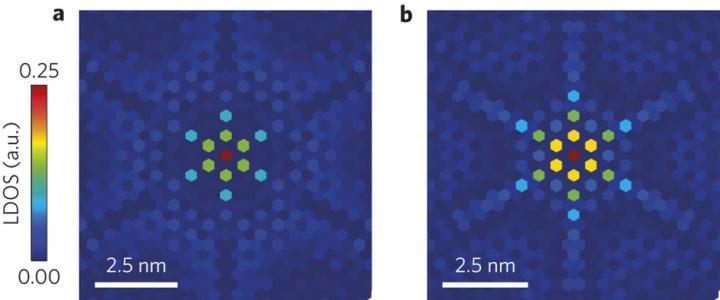

Nanostars
Credit: MIPT
Physicists from France and Russia have discovered magnetic disturbances in 2D superconductor layer, resembling little oscillating stars. These star-like excitations are caused by a single magnetic atom put into the layer of superconducting material.
What they mean is that now the Yu-Shibo-Rusinov chains are proved to exist not only in theory. Moreover, it was found out that in the two-dimensional systems the magnetic disturbances spread on longer distances and seem to be more sustainable – which brings us a step closer towards the long-awaited quantum computers. The results were published in Nature Physics this week.
According to one of the study's co-authors from MIPT, the observed effect looks like magnetic “nanostars in the superconducting univers”; building constellations of them can be used in quantum electronics.
Physicists from France and Russia have discovered that the magnetic atoms in a two-dimensional layered superconductor create electronic disturbances that look like oscillating “nanostars”. A “constellation” of these disturbances could be used in quantum electronics. The results of the study have been published in the prestigious scientific journal Nature Physics.
Prof. Dmitri Roditchev from the Superior School of Industrial Physics and Chemistry (ESPCI ParisTech, Paris), Gerbold Ménard,Dr. Christophe Brun, Dr. Tristan Cren from the Institute of Nanosciences of Paris at Sorbonne University, Dr. Vasily Stolyarov from the Laboratory of Topological Quantum Phenomena in Superconducting Systems at MIPT, and their colleagues from Paris-Saclay University studied the emergence of Yu-Shiba-Rusinov (YSR) states bound around single magnetic atoms embedded in a two-dimensional superconductor.
YSR states were theoretically predicted in the 1960s, but very few evidences for them have been experimentally revealed till now. In the present work it was found that in two-dimensional systems, magnetic excitations extend over a greater distance as compared to ordinary three-dimensional superconductors, and the emergent YSR quantum states are more stable, which makes them more suitable for developing a new generation of quantum electronics.
A crystal lattice of a layered superconducting material -niobium diselenide – was used in the tests. With an ultra-low-temperature scanning tunnelling microscope built by Roditchev, the researchers were able to observe , for the first time, YSR states around single magnetic atoms of iron. “We have demonstrated that the use of two-dimensional superconductors instead of the three dimensional ones results in an increase in the spatial extension of YSR states for several dozen nanometres, i.e. ten times further than in “normal” three-dimensional superconductors.
And the area of excitation was shaped like a six-fold electronic “star” with its rays extending along the axis of the crystal lattice of niobium diselenide. The observed “stars” are more stable and more suitable to creating new topologically protected states. Non-Abelian anyons can be collected from the YSR state chains, and can then be used as elements in quantum computers of the future,” says Vasily Stolyarov, a co-author of the study and the head of the Laboratory of Topological Quantum Phenomena in Superconducting Systems at MIPT.
The experiments described in the article were conducted in Paris. Work is underway at MIPT's Laboratory of Topological Quantum Phenomena in Superconducting Systems to create the experimental conditions necessary to obtain such high quality results. The Laboratory was set up in 2014 using funds from a mega grant awarded to Alexander Golubov, a professor at the University of Twente (Netherlands). The main purpose of the Laboratory is to study the quantum properties of new superconductors and topologically protected materials, and also hybrid artificial systems based on these materials.
The laboratory is being equipped in close cooperation with Roditchev's and Cren's groups and it is expected that the facilities at both laboratories will complement one another.
Yu-Shiba-Rusinov states were predicted in the late 1960s by three physicists from China, the USSR, and Japan independently of one another. They suggested that magnetic atoms introduced into a superconductor must create special states of excitation around themselves – electron-hole standing waves named after their discoverers. Calculations show that areas of topological conductivity may form around these states, where the current is only able to flow in one direction. Until recently, however, it had not been possible to confirm this prediction experimentally.
For the last 20 years, scientists have been attempting to create quantum systems that will outperform traditional semiconductor-based computers, the development potential of which is now almost exhausted. A number of potential “candidate” systems to be used as a base to build the components of a quantum computer are currently being investigated. The main problem preventing the development of these computers is the high sensitivity of the nanoworld to external influences that destroy quantum states. One promising option is to use topologically protected electron states that are resistant to decoherence. Non-Abelian anyons may be perfect for this; they are not negative ions, but rather special excitations in two-dimensional quantum systems in a magnetic field.
The theory predicts that such non-Abelian anyons may occur in a two-dimensional “liquid” of electrons in a superconductor under the influence of a local magnetic field. The electron liquid thus becomes degenerate, i.e. the electrons can have different states at the same energy level. The superposition of several anyons cannot be affected without moving them, therefore they are completely protected from disturbances.












